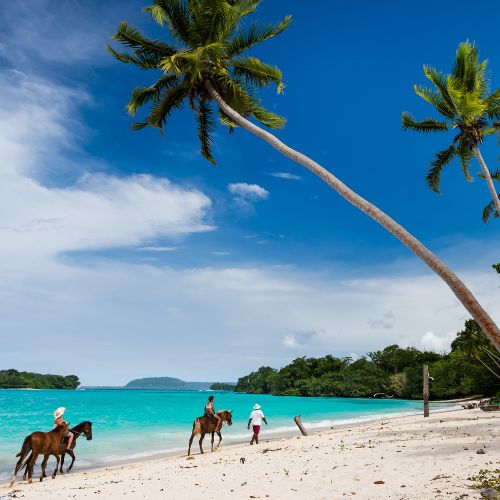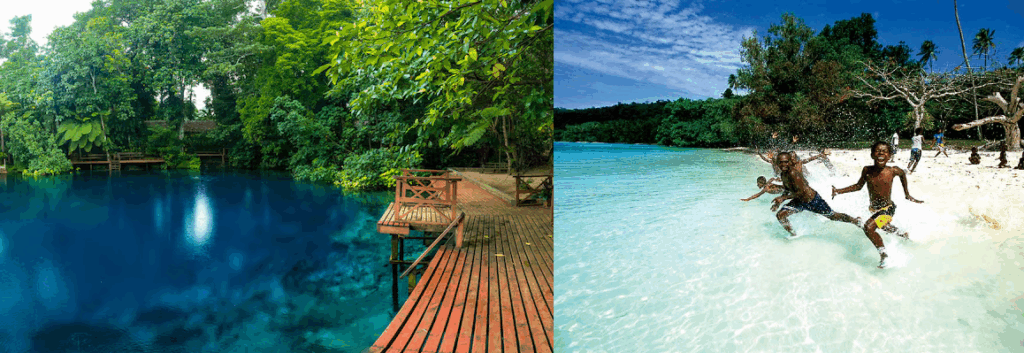Nestled in the cerulean waters of the South Pacific Ocean lies an archipelago of 83 islands known as Vanuatu. Located roughly 1,750 kilometers east of Australia and 500 kilometers northeast of New Caledonia, Vanuatu is a republic known for its raw natural beauty, vibrant indigenous culture, and rich marine biodiversity. Though relatively untouched by mass tourism, Vanuatu offers a wealth of experiences for the intrepid traveler seeking both relaxation and discovery.
Geographic and Cultural Overview
Vanuatu occupies a unique place both geographically and culturally. The islands stretch in a Y-shaped chain from north to south and feature a variety of terrains, from white-sand beaches and coral reefs to rainforests and active volcanoes. The population, approximately 300,000 people, is predominantly Melanesian, and the local culture is a vibrant mosaic of traditional customs, known as “kastom,” and contemporary island life.

Three official languages are spoken: Bislama (a creole language), English, and French, making communication accessible for most international visitors. The national currency is the Vanuatu Vatu (VUV).
Top Destinations to Explore
1. Port Vila (Efate Island)

As the capital and primary entry point to Vanuatu, Port Vila offers a harmonious blend of urban convenience and natural beauty. The city is perched on a picturesque harbor and features a vibrant waterfront lined with restaurants, markets, and craft stalls.
Notable Attractions:
- Mele Cascades: A stunning multi-tiered waterfall nestled in lush jungle, ideal for hiking and swimming.
- Hideaway Island: A marine sanctuary famous for its underwater post office and exceptional snorkeling opportunities.
- Vanuatu Cultural Centre: A museum offering insight into the country’s diverse customs and traditions.

2. Espiritu Santo

Known locally as “Santo,” this is the largest island in the archipelago and a must-visit for nature lovers and history enthusiasts.
Notable Attractions:
- Champagne Beach: Frequently listed among the world’s most beautiful beaches, it features pristine white sand and crystal-clear water.
- Blue Holes: These freshwater pools, formed by underground springs, are ideal for swimming and kayaking.
- SS President Coolidge: A sunken World War II troopship that is now one of the world’s top wreck dive sites.

3. Tanna Island

Tanna Island offers perhaps the most dramatic experience in Vanuatu: the opportunity to stand on the edge of an active volcano.
Notable Attractions:
- Mount Yasur: One of the world’s most accessible active volcanoes, offering nightly eruptions that light up the sky.
- Custom Villages: Explore local “kastom” villages to gain insight into traditional Melanesian life.
- Port Resolution: A bay with black sand beaches, hot springs, and fascinating geological features.


Activities and Experiences
Vanuatu is a destination for those who seek both adventure and tranquility. From the depths of the sea to the summit of a volcano, opportunities abound.
Water-Based Activities
- Scuba Diving & Snorkeling: The archipelago boasts coral reefs, underwater caves, and shipwrecks that cater to all skill levels.
- Kayaking & Paddleboarding: Calm lagoons and mangrove estuaries provide perfect conditions for paddling.
- Fishing & Sailing: Deep-sea fishing charters and sailing excursions are widely available.
Land-Based Activities
- Trekking: Trails across jungle landscapes and volcanic slopes offer breathtaking views.
- Cultural Tours: Engage with indigenous communities through village visits, dance ceremonies, and storytelling.
- Birdwatching & Eco-Tours: Discover endemic species in forest reserves and protected areas.
Gastronomy: What to Eat in Vanuatu
Vanuatu’s cuisine is a reflection of its fertile land and rich seas. Meals are typically prepared using fresh, organic ingredients and cooked using traditional methods such as earth ovens.
Signature Dishes:
- Laplap: The national dish made from grated root vegetables like yam or taro, mixed with coconut cream and meat or fish, then wrapped in banana leaves and baked.
- Tuluk: A cassava-based wrap filled with seasoned meat, often pork or beef.
- Poulet Fish: A white reef fish prized for its tender texture and often grilled.
Unique Delicacies:
- Coconut Crab: A local specialty available in certain areas, known for its rich flavor.
- Simboro: Vegetables and grated coconut rolled in taro leaves and steamed.
Beverages:
- Kava: A mildly narcotic drink made from the root of the kava plant, traditionally consumed during ceremonies.
- Fresh Juices: Made from local fruits like mango, passionfruit, and papaya.
When to Visit
The best time to visit Vanuatu is during the dry season, which runs from April to October. During this time, the weather is warm, sunny, and less humid. The wet season (November to March) can bring heavy rain and occasional cyclones, although it also features lush landscapes and fewer tourists.
Travel Tips
- Visa Requirements: Citizens from many countries (including the EU, UK, Australia, and New Zealand) do not require a visa for stays up to 30 days.
- Health & Safety: It is advisable to be up to date on vaccinations and consider anti-malarial medication depending on your itinerary.
- Currency Exchange: It is best to exchange money in Port Vila or use ATMs available in urban areas.
Vanuatu is a destination unlike any other. With its blend of untouched nature, vibrant culture, and genuine hospitality, it invites visitors to slow down, explore, and reconnect with the essence of travel. Whether you’re diving among coral reefs, watching molten lava explode into the night sky, or sharing a meal in a traditional village, Vanuatu delivers experiences that are both profoundly moving and deeply memorable.
For travelers seeking authenticity, adventure, and awe, Vanuatu is a journey worth taking.

